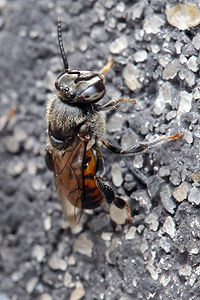
Photo from wikipedia
Pollinators in agricultural landscapes can be exposed to mixtures of pesticides and environmental pollutants. Existing mixture toxicity modelling approaches, such as the models of concentration addition and independent action and… Click to show full abstract
Pollinators in agricultural landscapes can be exposed to mixtures of pesticides and environmental pollutants. Existing mixture toxicity modelling approaches, such as the models of concentration addition and independent action and the mechanistic DEBtox framework have been previously shown as valuable tools for understanding and ultimately predicting joint toxicity. Here we apply these mixture models to investigate the potential to interpret the effects of semi-chronic binary mixture exposure for three bee species: Apis mellifera, Bombus terrestris and Osmia bicornis within potentiation and mixture toxicity experiments. In the potentiation studies, the effect of the insecticide dimethoate with added propiconazole fungicide and neonicotinoid insecticide clothianidin with added tau-fluvalinate pyrethroid acaricide showed no difference in toxicity compared to the single chemical alone. Clothianidin toxicity showed a small scale, but temporally conserved increase in exposure conducted in the presence of propiconazole, particularly for B. terrestris and O. bicornis, the latter showing a near three-fold increase in clothianidin toxicity in the presence of propiconazole. In the mixture toxicity studies, the dominant response patterns were of additivity, however, binary mixtures of clothianidin and dimethoate in A. mellifera, B. terrestris and male O. bicornis there was evidence of a predominant antagonistic interaction. Given the ubiquitous nature of exposures to multiple chemicals, there is an urgent need to consider mixture effects in pollinator risk assessments. Our analyses suggest that current models, particularly those that utilise time-series data, such as DEBtox, can be used to identify additivity as the dominant response pattern and also those examples of interactions, even when small-scale, that may need to be taken into account during risk assessment.
Journal Title: PLoS ONE
Year Published: 2017
Link to full text (if available)
Share on Social Media: Sign Up to like & get
recommendations!